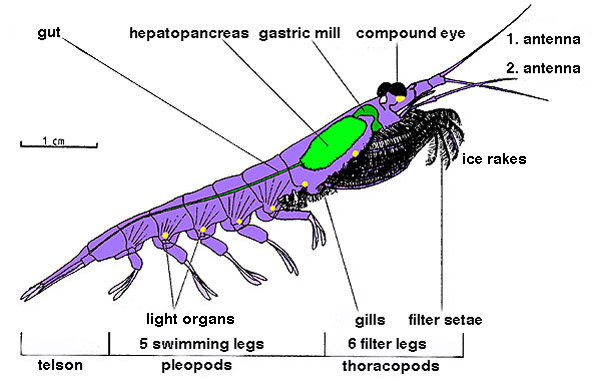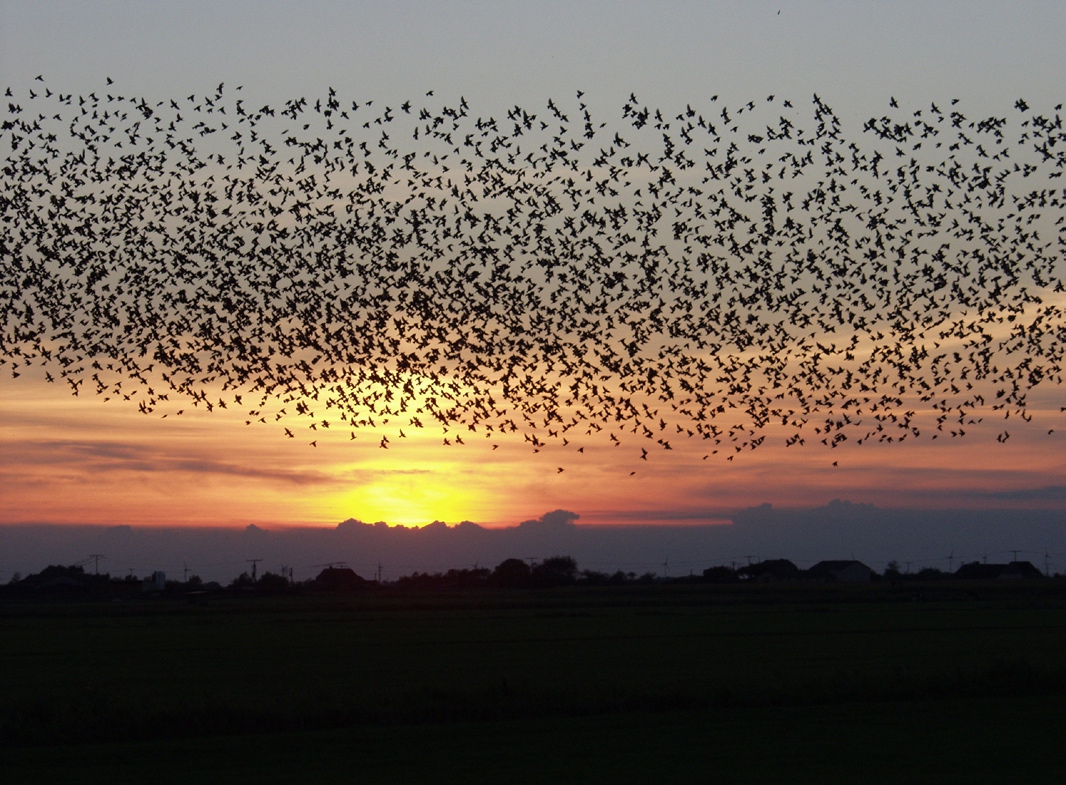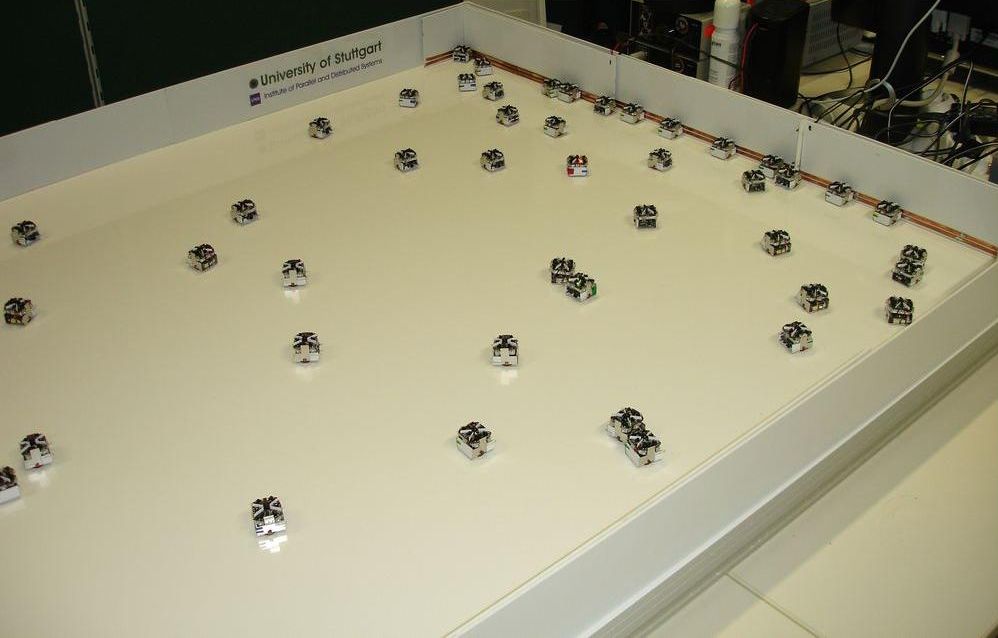|
Swarming
Swarm behaviour, or swarming, is a collective behaviour exhibited by entities, particularly animals, of similar size which aggregate together, perhaps milling about the same spot or perhaps moving ''en masse'' or migrating in some direction. It is a highly interdisciplinary topic. As a term, ''swarming'' is applied particularly to insects, but can also be applied to any other entity or animal that exhibits swarm behaviour. The term '' flocking'' or ''murmuration'' can refer specifically to swarm behaviour in birds, ''herding'' to refer to swarm behaviour in tetrapods, and ''shoaling'' or ''schooling'' to refer to swarm behaviour in fish. Phytoplankton also gather in huge swarms called ''blooms'', although these organisms are algae and are not self-propelled the way animals are. By extension, the term "swarm" is applied also to inanimate entities which exhibit parallel behaviours, as in a robot swarm, an earthquake swarm, or a swarm of stars. From a more abstract point of v ... [...More Info...] [...Related Items...] OR: [Wikipedia] [Google] [Baidu] |
Krill
Krill are small crustaceans of the order Euphausiacea, and are found in all the world's oceans. The name "krill" comes from the Norwegian word ', meaning "small fry of fish", which is also often attributed to species of fish. Krill are considered an important trophic level connection – near the bottom of the food chain. They feed on phytoplankton and (to a lesser extent) zooplankton, yet also are the main source of food for many larger animals. In the Southern Ocean, one species, the Antarctic krill, ''Euphausia superba'', makes up an estimated biomass of around 379,000,000 tonnes, making it among the species with the largest total biomass. Over half of this biomass is eaten by whales, seals, penguins, seabirds, squid, and fish each year. Most krill species display large daily vertical migrations, thus providing food for predators near the surface at night and in deeper waters during the day. Krill are fished commercially in the Southern Ocean and in the waters around Japa ... [...More Info...] [...Related Items...] OR: [Wikipedia] [Google] [Baidu] |
Flocking (behavior)
Flocking is the behaviour exhibited when a group of birds, called a flock, are foraging or in flight. Computer simulations and mathematical models that have been developed to emulate the flocking behaviours of birds can also generally be applied to the "flocking" behaviour of other species. As a result, the term "flocking" is sometimes applied, in computer science, to species other than birds. This article is about the modelling of flocking behaviour. From the perspective of the mathematical modeller, "flocking" is the collective motion by a group of self-propelled entities and is a collective animal behaviour exhibited by many living beings such as birds, fish, bacteria, and insects. It is considered an emergent behaviour arising from simple rules that are followed by individuals and does not involve any central coordination. In nature There are parallels with the shoaling behaviour of fish, the swarming behaviour of insects, and herd behaviour of land animals. During t ... [...More Info...] [...Related Items...] OR: [Wikipedia] [Google] [Baidu] |
Self-propelled Particles
Self-propelled particles (SPP), also referred to as self-driven particles, are terms used by physicists to describe autonomous agents, which convert energy from the environment into directed or persistent motion. Natural systems which have inspired the study and design of these particles include walking, swimming or flying animals. Other biological systems include bacteria, cells, algae and other micro-organisms. Generally, self-propelled particles often refer to artificial systems such as robots or specifically designed particles such as swimming Janus colloids, bimetallic nanorods, nanomotors and walking grains. In the case of directed propulsion, which is driven by a chemical gradient, this is referred to as chemotaxis, observed in biological systems, e.g. bacteria quorum sensing and ant pheromone detection, and in synthetic systems, e.g. enzyme molecule chemotaxis and enzyme powered hard and soft particles. Overview Self-propelled particles interact with each other, which ... [...More Info...] [...Related Items...] OR: [Wikipedia] [Google] [Baidu] |
Earthquake Swarm
In seismology, an earthquake swarm is a sequence of seismic events occurring in a local area within a relatively short period. The time span used to define a swarm varies, but may be days, months, or years. Such an energy release is different from the situation when a major earthquake (main shock) is followed by a series of aftershocks: in earthquake swarms, no single earthquake in the sequence is obviously the main shock. In particular, a cluster of aftershocks occurring after a mainshock ''is not'' a swarm. History and generalities In the Ore Mountains (Erzgebirge), which form the border between the Czech Republic and Germany, western Bohemia and the Vogtland region, have been known since the 16th century as prone to frequent earthquake swarms, which typically last a few weeks to a few months. Austrian geologist Josef Knett, while studying in 1899 a swarm of about a hundred events felt in western Bohemia/Vogtland in January-February 1824, coined the noun ''Schwarmbeben'', ... [...More Info...] [...Related Items...] OR: [Wikipedia] [Google] [Baidu] |
Collective Animal Behaviour
Collective animal behaviour is a form of social behavior involving the coordinated behavior of large groups of similar animals as well as emergent properties of these groups. This can include the costs and benefits of group membership, the transfer of information, decision-making process, locomotion and synchronization of the group. Studying the principles of collective animal behavior has relevance to human engineering problems through the philosophy of biomimetics. For instance, determining the rules by which an individual animal navigates relative to its neighbors in a group can lead to advances in the deployment and control of groups of swimming or flying micro-robots such as UAVs (Unmanned Aerial Vehicles). Examples Examples of collective animal behavior include: * Flocking birds * Herding ungulates * Shoaling and schooling fish * Schooling Antarctic krill * Pods of dolphins * Marching locusts * Nest building ants * Swarming * Stampede History The basis of coll ... [...More Info...] [...Related Items...] OR: [Wikipedia] [Google] [Baidu] |
Shoaling And Schooling
In biology, any group of fish that stay together for social reasons are shoaling, and if the group is swimming in the same direction in a coordinated manner, they are schooling. In common usage, the terms are sometimes used rather loosely. About one quarter of fish species shoal all their lives, and about one half shoal for part of their lives. Fish derive many benefits from shoaling behaviour including defence against predators (through better predator detection and by diluting the chance of individual capture), enhanced foraging success, and higher success in finding a mate. It is also likely that fish benefit from shoal membership through increased hydrodynamic efficiency. Fish use many traits to choose shoalmates. Generally they prefer larger shoals, shoalmates of their own species, shoalmates similar in size and appearance to themselves, healthy fish, and kin (when recognized). The oddity effect posits that any shoal member that stands out in appearance will be prefe ... [...More Info...] [...Related Items...] OR: [Wikipedia] [Google] [Baidu] |
Emergence
In philosophy, systems theory, science, and art, emergence occurs when an entity is observed to have properties its parts do not have on their own, properties or behaviors that emerge only when the parts interact in a wider whole. Emergence plays a central role in theories of integrative levels and of complex systems. For instance, the phenomenon of life as studied in biology is an emergent property of chemistry. In philosophy, theories that emphasize emergent properties have been called emergentism. In philosophy Philosophers often understand emergence as a claim about the etiology of a system's properties. An emergent property of a system, in this context, is one that is not a property of any component of that system, but is still a feature of the system as a whole. Nicolai Hartmann (1882–1950), one of the first modern philosophers to write on emergence, termed this a ''categorial novum'' (new category). Definitions This concept of emergence dates from at lea ... [...More Info...] [...Related Items...] OR: [Wikipedia] [Google] [Baidu] |
Swarm Robotics
Swarm robotics is an approach to the coordination of multiple robots as a system which consist of large numbers of mostly simple physical robots. ″In a robot swarm, the collective behavior of the robots results from local interactions between the robots and between the robots and the environment in which they act.″ It is supposed that a desired collective behavior emerges from the interactions between the robots and interactions of robots with the environment. This approach emerged on the field of artificial swarm intelligence, as well as the biological studies of insects, ants and other fields in nature, where swarm behaviour occurs. Definition The research of swarm robotics is to study the design of robots, their physical body and their controlling behaviours. It is inspired but not limited by the emergent behaviour observed in social insects, called swarm intelligence. Relatively simple individual rules can produce a large set of complex swarm behaviours. A key component ... [...More Info...] [...Related Items...] OR: [Wikipedia] [Google] [Baidu] |
Craig Reynolds (computer Graphics)
Craig W. Reynolds (born March 15, 1953), is an artificial life and computer graphics expert, who created the Boids artificial life simulation in 1986. Reynolds worked on the film ''Tron'' (1982) as a scene programmer, and on ''Batman Returns'' (1992) as part of the video image crew. Reynolds won the 1998 Academy Scientific and Technical Award The Scientific and Technical Awards are three different Honorary Awards that are given by the Academy of Motion Picture Arts and Sciences (AMPAS) during the annual Academy Awards season. The Awards have been presented since the 4th Academy Awards ... in recognition of "his pioneering contributions to the development of three-dimensional computer animation for motion picture production." He is the author of the '' OpenSteer'' library. References External linksCraig Reynolds' home page * [...More Info...] [...Related Items...] OR: [Wikipedia] [Google] [Baidu] |
Hydrodynamic
In physics and engineering, fluid dynamics is a subdiscipline of fluid mechanics that describes the flow of fluids—liquids and gases. It has several subdisciplines, including ''aerodynamics'' (the study of air and other gases in motion) and hydrodynamics (the study of liquids in motion). Fluid dynamics has a wide range of applications, including calculating forces and moments on aircraft, determining the mass flow rate of petroleum through pipelines, predicting weather patterns, understanding nebulae in interstellar space and modelling fission weapon detonation. Fluid dynamics offers a systematic structure—which underlies these practical disciplines—that embraces empirical and semi-empirical laws derived from flow measurement and used to solve practical problems. The solution to a fluid dynamics problem typically involves the calculation of various properties of the fluid, such as flow velocity, pressure, density, and temperature, as functions of space and time. Be ... [...More Info...] [...Related Items...] OR: [Wikipedia] [Google] [Baidu] |
Lateral Line
The lateral line, also called the lateral line organ (LLO), is a system of sensory organs found in fish, used to detect movement, vibration, and pressure gradients in the surrounding water. The sensory ability is achieved via modified epithelial cells, known as hair cells, which respond to displacement caused by motion and transduce these signals into electrical impulses via excitatory synapses. Lateral lines serve an important role in schooling behavior, predation, and orientation. Fish can use their lateral line system to follow the vortices produced by fleeing prey. Lateral lines are usually visible as faint lines of pores running lengthwise down each side, from the vicinity of the gill covers to the base of the tail. In some species, the receptive organs of the lateral line have been modified to function as electroreceptors, which are organs used to detect electrical impulses, and as such, these systems remain closely linked. Most amphibian larvae and some fully aquati ... [...More Info...] [...Related Items...] OR: [Wikipedia] [Google] [Baidu] |
Auklet Flock Shumagins 1986
An auk or alcid is a bird of the family Alcidae in the order Charadriiformes. The alcid family includes the murres, guillemots, auklets, puffins, and murrelets. The word "auk" is derived from Icelandic ''álka'', from Old Norse ''alka'' (auk), from Proto-Germanic *''alkǭ'' (sea-bird, auk). The family contains 25 extant or recently extinct species that are divided into 11 genera. Apart from the extinct great auk, all auks can fly, and are excellent swimmers (appearing to "fly") and divers, but their walking appears clumsy. Several species have different English names in Europe and North America. The two species known as murres in North America are called guillemots in Europe, and the species called little auk in Europe is referred to as dovekie in North America. Description Auks are superficially similar to penguins, having black-and-white colours, upright posture, and some of their habits. Nevertheless, they are not closely related to penguins, but rather are believed to ... [...More Info...] [...Related Items...] OR: [Wikipedia] [Google] [Baidu] |








